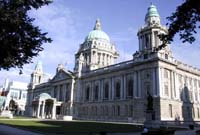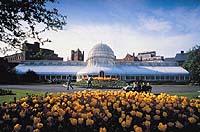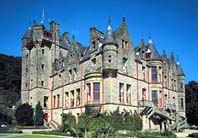Vacation Guide
Ireland golf vacation guide :
City and regional guide - Belfast
 This robust Northern Ireland capital city has undergone much change over the years. Belfast was the engine-room of the Industrial Revolution in Northern Ireland and during the Victorian era, was an industrial boomtown, whose prosperity was based on its thriving shipbuilding, linen and rope-making industries. Shipbuilding in particular was of huge importance in Belfast and it was here that the Titanic was built. For some decades now, Belfast has been hit by collapsing industries and of course the ongoing troubles in the North. But following the ceasefire of 1994 and subsequent peace agreements, Belfast has benefited from major tourism investment and has undergone somewhat of a facelift as a city.
This robust Northern Ireland capital city has undergone much change over the years. Belfast was the engine-room of the Industrial Revolution in Northern Ireland and during the Victorian era, was an industrial boomtown, whose prosperity was based on its thriving shipbuilding, linen and rope-making industries. Shipbuilding in particular was of huge importance in Belfast and it was here that the Titanic was built. For some decades now, Belfast has been hit by collapsing industries and of course the ongoing troubles in the North. But following the ceasefire of 1994 and subsequent peace agreements, Belfast has benefited from major tourism investment and has undergone somewhat of a facelift as a city.
Superficially (at least until a few years ago), Belfast may be described as a large, rather ugly industrial city but Belfast of course, is not just any city - its politics and history are interwoven into its very fabric. For visitors, Belfast is a compact city with relatively light traffic in comparison to other major cities and is easy to navigate by foot. The major central landmark is Donegall Square, which is surrounded by imposing remnants of the Victorian era, while at the southern end; the Queen’s University area is the most appealing part of the city. It is here that one can find the Botanic Gardens, fine 19th century buildings and many excellent restaurants.
Today, Belfast is a vibrant city with many attractions for the visitor. Donegall Square, the main shopping area in Belfast, is dominated by City Hall, which was built around the turn of the 20th century. Built in the Classical Renaissance style with an Italian marble interior, the view of the Great Dome from the entrance hall is a feast for the eyes, while its series of arches stained-glass windows; ornate plasterwork and paintings are very impressive. Located near City Hall, the Linen Hall Library, which houses a major Irish literary collection is well worth a visit.
 Laid out in 1827 on land that slopes down to the River Lagan between Queen’s University and the Ulster Museum is the Botanic Gardens. The gardens provide a great escape from the city and are a wonderful haven of grass, trees, flowers and walks. The Palm House in the gardens, constructed from curved iron and glass is reckoned to be the largest such greenhouse in the world, while the Tropical Ravine House displays a range of tropical plants. Beside the gardens, the Ulster Museum is well worth a visit. Its collections include contemporary Irish and International art but the main attraction is probably the collection of jewelry that was recovered by divers in 1968 from one of the Spanish Armada ships, wrecked off the coast of the Giant’s Causeway in 1588.
Laid out in 1827 on land that slopes down to the River Lagan between Queen’s University and the Ulster Museum is the Botanic Gardens. The gardens provide a great escape from the city and are a wonderful haven of grass, trees, flowers and walks. The Palm House in the gardens, constructed from curved iron and glass is reckoned to be the largest such greenhouse in the world, while the Tropical Ravine House displays a range of tropical plants. Beside the gardens, the Ulster Museum is well worth a visit. Its collections include contemporary Irish and International art but the main attraction is probably the collection of jewelry that was recovered by divers in 1968 from one of the Spanish Armada ships, wrecked off the coast of the Giant’s Causeway in 1588.
Oppsite the Europa Hotel on Great Victoria Street is the Crown Liquor Saloon, without doubt Belfast’s most famous pub. Built in 1894, the bar offers carved woodwork, cosy snugs and leather seats in a great environment. The Crown Liquor Saloon marks the northern end of an area known as the Golden Mile. Extending from Howard Street in the north to Shaftesbury Square in the south and bordered by Great Victoria Street and Bedford Street, the Golden Mile is an area rich in historic buildings, hotels, civic buildings, restaurants, cafés and stores. The Grand Opera House on Great Victoria Street is worth a look even if you don’t intend going to a show. Designed in 1894, the building was restored in the 1970’s and offers fantastic plasterwork and beautiful ceiling fresco by renowned Irish artist Cherith McKinstry.
 Situated in Cave Hill Country Park just outside the city and overlooking Belfast Lough is Belfast Castle, originally built for the Marquis of Donegall in 1865. Today the Castle functions mainly as a restaurant and is the ideal venue to sample excellent cuisine in a wonderful atmosphere. It also houses the Cave Hill Heritage Centre, which provides information about the Castle and its surroundings. Belfast Zoo, which is one of the finest in Europe, is also located on the slopes of Cave Hill. About ten miles northeast of Belfast is the Ulster Folk and Transport Museum, which tells the story of the province’s social history. The North’s past is brought to life with a series of reconstructed buildings including a traditional weaver’s dwelling, an 18th century church, a flax mill, forge, farmhouse and rural school. Just across the road is the Transport Museum, where the exhibitions include a section on the Titanic, which so famously sank on its maiden voyage in 1912.
Situated in Cave Hill Country Park just outside the city and overlooking Belfast Lough is Belfast Castle, originally built for the Marquis of Donegall in 1865. Today the Castle functions mainly as a restaurant and is the ideal venue to sample excellent cuisine in a wonderful atmosphere. It also houses the Cave Hill Heritage Centre, which provides information about the Castle and its surroundings. Belfast Zoo, which is one of the finest in Europe, is also located on the slopes of Cave Hill. About ten miles northeast of Belfast is the Ulster Folk and Transport Museum, which tells the story of the province’s social history. The North’s past is brought to life with a series of reconstructed buildings including a traditional weaver’s dwelling, an 18th century church, a flax mill, forge, farmhouse and rural school. Just across the road is the Transport Museum, where the exhibitions include a section on the Titanic, which so famously sank on its maiden voyage in 1912.
Choose another destination
• Aran Islands •Belfast •Connemara •Cork •Dublin •Galway •Kilkenny
•Killarney •Waterford •Wexford •Wicklow



